#natural language interface
Text
What is the rabbit r1? The Future of Personal Technology
In the rapidly evolving landscape of technology, a groundbreaking device has emerged that aims to revolutionize the way we interact with our digital world. Meet the rabbit r1, an innovative gadget that blends simplicity with sophistication, offering a unique alternative to the traditional smartphone experience. This article delves into the essence of the rabbit r1, exploring its features,…

View On WordPress
#128GB storage#360-degree camera#4G connectivity#AI in daily life#AI-powered device#analog scroll wheel#app-free experience#cloud-based solutions#compact device#digital decluttering#digital simplification#future of smartphones#intuitive technology#Large Action Model#MediaTek P35#modern tech solutions#natural language interface#online services simplification#personal assistant devices#personal technology#Rabbit Inc#Rabbit OS#rabbit r1#smart gadgets#tech trends 2024#technology innovation
0 notes
Text
Power of Natural Language Processing with AWS
Dive into the world of Natural Language Processing on AWS and learn how to build intelligent applications with services like Amazon Comprehend, Transcribe, and Polly. Explore the future of language-driven AI and cloud computing #AWSNLP #AI #CloudComputing
Natural Language Processing (NLP) has emerged as a transformative force in the realm of artificial intelligence, enabling computers to comprehend and generate human-like text. As businesses increasingly recognize the value of language-driven insights and applications, cloud platforms such as Amazon Web Services (AWS) have played a pivotal role in democratizing access to advanced NLP capabilities.…

View On WordPress
#AI Development#AI Services#Amazon API Gateway#Amazon Comprehend#Amazon Lex#Amazon Polly#Amazon Transcribe#Amazon Translate#amazon web services#aws#AWS Lambda#chatbot development#Cloud Computing#Cloud Services#Conversational Interfaces#Language Processing Applications#Language Understanding#Machine Translation#natural language processing#Neural Machine Translation#NLP#sentiment analysis#speech recognition#Text Analysis#text-to-speech#Voice Interfaces
4 notes
·
View notes
Text

0 notes
Text
Understanding the Potential of Voice User Interfaces in Web Applications
Explore the cutting-edge collaboration of Voice User Interfaces, Natural Language Processing, and Conversational Interfaces, exploring a new era of user-centric UIUX design. Witness the transformative power of Speech Recognition in web applications, driving a digital transformation that redefines user experience. Visit the link for more details.
0 notes
Text
Mastering the Art of Communicating with AI
As we enter a new era of technological advancement, communication with artificial intelligence (AI) has become increasingly important. The art of communicating with AI is an essential skill that individuals and businesses alike must possess to navigate this new terrain.
To start, it is essential to understand the intricacies of AI language. Unlike human language, which can be ambiguous and…

View On WordPress
#artificial intelligence#chatbots#communication skills#conversational interfaces#Design#Designer#Graphic design#human-computer interaction.#laiq ahmed qureshi#LaiqQureshi#laiqverse#machine learning#Mastering the Art of Communicating with AI#natural language processing#virtual assistants#voice assistants#Writing Prompts
1 note
·
View note
Photo
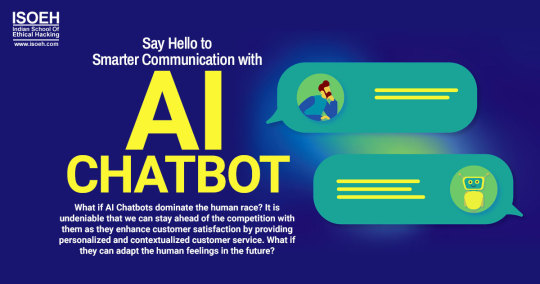
Smart AI Chatbots understands customers' language and expressions and has real-time solving power with accurate answers. Explore its benefits and limitations.
#AI Chatbot#Natural language processing (NLP)#Machine learning (ML)#Artificial intelligence (AI)#Conversational interface#Virtual assistant#Customer service#Chatbot development#Personalization#Automation#User experience (UX)#Human-like interactions#Sentiment analysis#Multilingual support#Text-to-speech (TTS)#Voice recognition#Data analytics#Omnichannel support#Dialog management#Intent recognition#Active Learning#Maximizing efficiency#Customers' value#Chatbots
0 notes
Note
doing the TikTok couple outfit trend with nerd!miguel




this just sent me to my early grave btw
cw: none! fluff with barely one instance of suggestive language. also maybe angst if you squint. gn!reader with a fem outfit!
wc: ~ 600
❤︎ a/n: this was so cute im :(((. if you haven’t see the trend nonnie was referencing, here is an example! proofread today yippee!! happy reading <3
*all pictures are just for scene setting! reader has no specific race, genitals, body type, or pronouns mentioned!*

put the timer on before you press play,” you laugh, watching miguel fiddle with your phone. as tech savvy as he is, you find it endearing that he can’t operate tiktok properly.
the two of you were on a park date, picnic basket in hand as the sun shines overcast, warming your skin, matching the warmth you’ve been feeling all day. after a rough week, miguel had offered to cheer you up, by way of picnic, and you agreed, albeit with reluctance.
it had been your idea to match, of course. the small unspoken ways you feel comfortable giving affection towards him without outwardly saying the three words that stir and uneasy feeling in you.
naturally for a picnic, you opted for gingham, red of course, sporting by way of a long sleeved off the shoulder crop top with lace trim, and a denim mini skirt to match. the shoes were less understated with the farmers look you had going on, your steve madden platform sandals bringing your more than necessary edge to your outfit. miguel, still hunched down finicking with your phone, matched with you, wearing a red gingham shirt, unbuttoned with a white tee underneath. his light-wash blue jeans sat well on his hips, held up by a black leather belt, the same color as the loafers on his feet.
you had seen an influx of videos of couples on vacations and regular outings matching outfits and chronicling it in form of tiktoks, and some part of you felt like it would make you feel all the more conflicted in your feelings, but the other part of you wanted to hold hands with miguel and show off your matching outfits to the world, and the former part of you won.
bringing you back to now, where miguel finally has managed to set up the timer for your tiktok, but not without muttering, “the user interface is stupid. anyone could have trouble with it.” you can only laugh, admiring his clean shaven face, pouted lips, strong nose and soft eyes as he looks at you and asks if he can press play yet. you fix his hair, looping the little piece in the front around your finger to fix the curl and look at him in the eyes, his face red.
“yes.”
-
“miguel, you cross your legs, and then clap. not the other way around. this is the second time!”
“that’s not what they did in the video i saw..”
“that’s because it’s not the one i sent you. i suggested this, so we’re doing it my way, not yours.”
after three takes of miguel either crossing his legs the wrong way or completely missing his cue, you were sure this take would be it.
so when he presses play and the timer goes off, you watch the minuscule versions him and you in your phones screen, and by some high power, you’re both in sync. and can help but laugh and exclaim your joy, pull him in for a kiss at his success. a kiss in which miguel gladly returns, lipstick marks be damned.
you look away shyly when you pull away. “knew you could do it,” you say, gaze lowered to the gold chain hanging from miguel’s thick neck.
“only cause i listened to you, my love,” he returns, bringing your gaze to his by pushing your head up with his index finger at your chin.
you give him a light pec before slapping his chest softly. “should have been listening to me the whole damn time. i’ve been too nice to you lately.”
“teach me a lesson later,” he says, the look of mischief in his eyes not unnoticed by you. “first, we eat. c’mom.”
with his hand in yours, you stroll through the park. together, and happy.

#miguel o’hara x you#miguel o'hara#miguel o’hara drabble#miguel o’hara x reader#miguel o’hara x y/n#miguel o’hara imagine#miguel o’hara headcanon#miguel o’hara angst#miguel o’hara fluff#miguel atsv#atsv miguel#gn!reader x miguel o’hara#fem!reader x miguel o’hara#male!reader x miguel o’hara#you’ve got mail💌#<nerd!miguel3
211 notes
·
View notes
Text
The Future
Time to establish what's going to happen from this point forwards.
The vast majority of you have been exceptionally patient this last year, and for that you have my deepest thanks. You've given me the time to not only write a book, but edit it, and send it off to literary agents, something I would have long given up on doing without the continued support of those who enjoy my writing.
Now that the book is off doing the rounds independently, it's time I got back to Myrk Mire.
Originally Myrk Mire was built in ChoiceScript, a scripting language created by the Choice of Games company. Choice of Games control what is done with their script, understandably, they own it. This does pose some restrictions. I can't, for example, release any paid material built using ChoiceScript unless it is directly through their publishing label. If I do publish under their label, I maintain IP or Intellectual Property Rights, however I also grant them the exclusive rights under perpetual license to publish the multiple choice game 'electronically'.

Source: Choice of Games.com
As you can see from the outline above, they do make exceptions for stories published in non-competing formats, and for sequels, prequels, and spin-offs. However, traditional publishing houses might require stricter control over IP, distribution, and exclusivity. It will only become more and more complicated as things progress, and being locked into a perpetual license agreement of any nature is not a decision to make lightly.
As some of you may be sensing from the tone of all this so far, I'm going to be moving Myrk Mire away from Choice of Games and ChoiceScript, and into a new medium/format.
After tinkering, and trialling with a few alternatives, I've decided to go with Renpy. Renpy, while largely used for visual novel style games and stories, provides a very workable framework for interactive fiction, and is an Open Source script, it isn't beholden to publishing contracts, licence cost, or exclusivity.
I'm not going to be diving into transferring Myrk Mire right away, it's a huge piece of writing, in an entirely different scripting language, and as previously stated, there are a lot of changes I want to implement with the cast. Instead, I'm creating a trial story: One Háḟest Day. My Patrons have been aware of all this for about a month or so, and have already seen some previews.
One Háḟest Day takes place in Aldmirham before the events of Myrk Mire, around the time the Main Character and the Wanderers first arrived in town. The reader will have the choice to follow one of the romanceable characters through a single day, with opportunities to explore their lives and relationships before the Main Character and Child come along. I hope it will provide a proving ground for the changes that previously caused debate, and an opportunity for people to try out the new format and interface.
My plan is to distribute One Háḟest Day through Itch.io, working with their early access framework and voluntary payments for such as soon as one of the character routes is ready to play from beginning to end, updating regularly with the other characters as they too are completed, and with additional features as required. Once the full game is complete, I will release a separate full build with a set minimum price that can be discussed with the community as we move forwards.
At the second, I'm aiming for a web hosted format and a desktop/laptop downloadable format, with phone compatibility to come later down the line once things are stable.
I will post production updates and info when I can to tumblr, though a lot of what I'm doing now is very python coding heavy, so perhaps not that interesting?
I've included some screenshots below of very early development, featuring a Character Log and Word Log that I hope will allow readers to more easily navigate the story. I'm toying with the idea of having a Mysteries Log as well that will keep track of snippets of information gleaned from each character's route, but that can be a tinkering feature for now.
Let me know your thoughts, concerns, or excitement, though do keep all messages objective and polite.

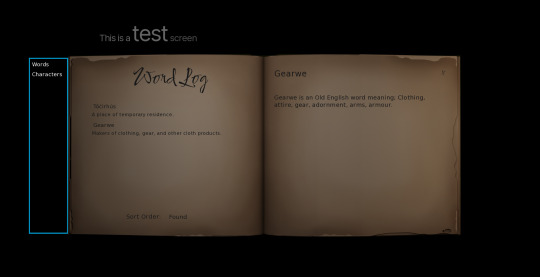
170 notes
·
View notes
Note
hi!! i hope you’re having a lovely day :-) i really enjoy reading your blog and how you pick apart Things & was wondering if you have any tips and guides for reading and analyzing poetry? ive always struggled w forming coherent thoughts abt poems and would love to know how you approach it. thank you sm for your time ✨
so the big thing that made poetry "click" for me was realising that i was trying to read it the way i might try to read a novel -- identify a discourse taking place, look for points in the text that supplement my argument, construct a position on what the piece is "about" based on these points -- all very undergrad essay-core and frankly a v boring way to think about novels as well, but like, completely mind-numbing when it came to poetry. i think a better approach is to interface with the poem at the level of language and technical construction. i find that it helps a lot to know the technical terms for particular phenomena in the language of poetry, but even without that shorthand knowledge, you'll get a lot out of poetry when you start looking at the choices being made at the level of individual words or even syllables. so instead of asking "what is this poem about?", we can start to ask, for instance:
what is the tone of this poem? is it sparing or loquacious? emotional or detached? asking questions or answering them? what's the vantage point - is this a detached omniscient third-person narrator making observations, or are we as the reader being guided towards a particular perspective on the part of the speaker?
what is the mouthfeel of this poem? can you find any 'shapes' -- any assonance, any internal rhyming, alliteration, anything that causes you to pay attention to particular words, phrasing, etc. why is your attention being called to those moments?
what is the rhythm of the poem? is it free verse -- if so, can you find any points in the piece where more or less attention to rhythm is being paid? why does the line break on this particular word? are the sentences short or long? how is the poet interfacing with their chosen meter? what does this meter lend to the poem? if you're reading multiple works by the same author, compare their use of meter -- do they use the same meter regularly or switch it up, and why were those switches made?
if you can annotate a poem, do so. note down anything which seems linguistically interesting, even if you don't know the "correct" technical word for it -- any clusters of words with similarities whose placement might be interesting (eg. what words are rhymed!), any noteworthy rhythmic discrepancies, placement of line breaks, anything that sticks out. i like to think of reading poetry as a playful exercise -- you're playing around with the words, seeing how they work, enjoying the rhythm and texture of the piece as it comes to you, and trying to construct "a reading" only after the fact.
i think there are times when the reading-for-a-discourse approach can be v helpful and illuminating, but it's best to stumble on those opportunities organically rather than focusing all your energy on trying to answer the "what is this trying to say?" question. if a particular discursive component of a poem sparks your interest (like eg. you read the rime of the ancient mariner and notice how the poem interfaces with contemporaneous abolitionist discourses as well as colonialist ideas about polynesia, just as an example), you've obviously got a compelling hook from which you can anchor a reading, but going in expecting such a reading to jump off the page will often just result in frustration.
this doesn't mean that we don't take the discourse of a poem seriously, or that we don't understand the "rules" of poetry to be postdiscursive phenomena highly contingent on social context. if anything, understanding poetry at a mechanical level opens up significant doors for answering these types of questions -- we can understand, for example, the reactionary nature of the academic revolt against free verse and the desire to return to metered poetry better once we understand the function of form and structure in fascist aesthetics. similarly, spending this kind of time with a poem makes it a lot easier to get a handle on what it might be "about," and what sort of choices are being made to render that "about"ness coherent.
also -- and this is true of anything, including poetry -- if a poet isn't working for you, try reading somebody else. a lot of poets that people will say are good and interesting are neither of those things. poetry has the advantage of being (usually!) a quick read compared to novels, so it's far easier to shop around, read widely, realise what you like and dislike, and engage accordingly.
one of my favourite pieces of literary criticism and examples of the value of this sort of reading practice comes from nabokov's epilogue to lolita, in which he both defends the novel in question against accusations of salacity and speaks very disparagingly of efforts to read a thesis statement into it. he writes:
Every serious writer, I dare say, is aware of this or that published book of his as of a constant comforting presence. Its pilot light is steadily burning somewhere in the basement and a mere touch applied to one’s private thermostat instantly results in a quiet little explosion of familiar warmth. This presence, this glow of the book in an ever accessible remoteness is a most companionable feeling, and the better the book has conformed to its prefigured contour and color the ampler and smoother it glows. But even so, there are certain points, byroads, favorite hollows that one evokes more eagerly and enjoys moretenderly than the rest of one’s book. I have not reread Lolita since I went through the proofs in the spring of 1955 but I find it to be a delightful presence now that it quietly hangs about the house like a summer day which one knows to be bright behind the haze. And when I thus think of Lolita, I seem always to pick out for special delectation such images as Mr. Taxovich, or that class list of Ramsdale School, or Charlotte saying “waterproof,” or Lolita in slow motion advancing toward Humbert’s gifts, or the pictures decorating the stylized garret of Gaston Godin, or the Kasbeam barber (who cost me a month of work), or Lolita playing tennis, or the hospital at Elphinstone, or pale, pregnant, beloved, irretrievable Dolly Schiller dying in Gray Star (the capital town of the book), or the tinkling sounds of the valley town coming up the mountain trail (on which I caught the first known female of Lycaeides sublivens Nabokov). These are the nerves of the novel. These are the secret points, the subliminal co-ordinates by means of which the book is plotted—although I realize very clearly that these and other scenes will be skimmed over or not noticed, or never even reached, by those who begin reading the book under the impression that it is something on the lines of Memoirs of a Woman of Pleasure or Les Amours de Milord Grosvit. That my novel does contain various allusions to the physiological urges of a pervert is quite true. But after all we are not children, not illiterate juvenile delinquents, not English public school boys who after a night of homosexual romps have to endure the paradox of reading the Ancients in expurgated versions.
It is childish to study a work of fiction in order to gain information about a country or about a social class or about the author. And yet one of my very few intimate friends, after reading Lolita, was sincerely worried that I (I!) should be living “among such depressing people” —when the only discomfort I really experienced was to live in my workshop among discarded limbs and unfinished torsos.
#ask#also i know this approach is unbearable to some people. but truly it is what made poetry work for me. so!
228 notes
·
View notes
Text
LLMs for search: the good version
I sometimes see people make the following argument:
Google search sucks now. It gives you pages and pages of SEO garbage, and it opaquely/obtusely "interprets" your query text rather than just giving you what you asked for. Other search engines aren't dramatically better.
Therefore, web search is ripe for disruption. If something came along that didn't suck, Google's dominance could easily be broken.
Therefore, "New Bing" and the like -- LLM chatbots that summarize search results to you -- are the wave of the future.
(Am I straw manning, here? I remember reading something very close to this in a blog post that got passed around early this year, but I can't find it now.
In any case, many people -- including Google management -- now believe that New Bing is a threat to Google's dominance. I don't know why people really believe this, but "people aren't satisfied with Google" is clearly one of the factors.)
----
Step 3 is an obvious non sequitur.
LLM interfaces to existing search indices don't address any of the things people hate about Google.
They don't solve the problem of SEO garbage. When I ask questions to New Bing, I usually get a digested summary of a few articles from the top Bing results for a query, which are ... SEO garbage.
Only now, they've been garbled even further by the LLM. In their current form, these systems do not adequately explain the evidential relationships between their verbal summaries and the search results, and sometimes introduce errors along the way:
We find that responses from existing generative search engines are fluent and appear informative, but frequently contain unsupported statements and inaccurate citations: on average, a mere 51.5% of generated sentences are fully supported by citations and only 74.5% of citations support their associated sentence. We believe that these results are concerningly low for systems that may serve as a primary tool for information-
seeking users, especially given their facade of trustworthiness.
[The average is over 4 different products. For Bing specifically, the numbers are 59% and 90% respectively. -nost]
(source)
Do they address the problem of "interpreting the query"? Yes and no.
They add a new layer of interpretation: (natural-language question) is interpreted to compose (search query) is interpreted to produce (search results).
Ideally, you'd drop the interpretation in the latter step, making the pure search part more like old Google. And then, hopefully, the first step is "smarter" and less obtuse than what exists in Google now, because it uses a powerful LLM.
That's the ideal case -- I don't know if Bing actually does this, and if not, they're doing something worse.
And even in the ideal case, this just seems kind of . . . silly? The LLM is being used as a "compiler" to convert natural-language questions into search queries for "old, more-literalistic Google" or an equivalent.
But people happily used "old Google" without any assistance, for many years -- and by "people" I don't just mean tech people, I mean everyone! "Google it" became a household term long before Google search started doing the level of aggressive interpretation it does today. It was fine! In fact, people want it back!
The "ideal case" above presumes you can construct something like "old Google" for the LLM to issue queries to. But if you can do that, you've already solved the problem! The chatbot can be discarded, it's not adding anything.
Likewise for SEO spam. How could you stop Bing from just summarizing SEO spam? Well, you could either
Let it talk to a search index that's not dominated by spam
Give it some LLM-based SEO-filtering capability so it can skip the spam results
But again, if you've achieved either of these things, you've already solved the problem. At this point, adding the chatbot doesn't make it any more solved.
----
On the other hand, you could totally use LLMs to address the SEO problem, couldn't you?
Like, SEO garbage is easy to distinguish from other kinds of web pages. I'm sure modern LLMs could do a near-perfect job at sifting the two apart.
(Indeed, you don't even need a modern LLM. Much weaker ML models could probably do the job. But everyone wants to do stuff with LLMs now, so fine, let's go with that.)
So, why not just ... use this as a filter on top of search? That is,
Issue the search.
Behind the scenes, fetch the top N pages for some N, and send them (or a substring of each one) to a model, asking it to judge whether it's spam or not. The exact definition of "spam" for this purpose could be refined to taste.
Show the user a results page containing only the results the model said were OK.
(Or, better, include the bad ones behind some "...X results have been hidden..." UI element you have to click, like on twitter with replies. Or whatever. Many possibilities.)
You don't have to wait for Google or MS to do this themselves. Couldn't you do this as a browser extension or something? Is there a reason this wouldn't work?
(It would cost some money to run, but if it really worked, it seems plausible that people would value it at some price above operating costs. Or, not obviously implausible.
It would be slow, which could easily be a dealbreaker.)
Now, obviously, if this got really popular, then SEO would start adapting to it.
But that isn't a reason to dismiss the idea.
First, this would only happen if the tool got really popular, and it wouldn't be instantaneous or perfect. SEO companies are companies, with procedures and ingrained habits, and they're already trying hard to adapt to changes in the indexes themselves. Adapting simultaneously to this new threat would not necessarily be easy.
Second, this tool has an SEO-fighting advantage that the search companies don't. The search companies have to index and rank everything, and serve results to everyone at once, with all the work/costs imposed on the server and not the client. That might mean accepting lower-quality heuristics for the sake of volume.
But this tool just has to process a shorter list of results, once per query. (Even better, perhaps the results could be centrally cached and re-used across users/queries when available.) As long as Google is good enough that there's some useful items in the top N hits, for some not-too-large N, you can piggy-back on top of the work Google has already done, and solve a much smaller problem. And you can do the work at runtime, on the client / on OpenAI.
And with LLMs providing the "heuristics," SEO adaptation is not so easy. Like I said, we all know SEO garbage when we see it -- and LLMs are very good at mimicking human snap judgments like this, in a way that is stable across changes in surface-level features.
Re-jiggering the style and format of the SEO content won't trick the LLMs, for the same reason it wouldn't satisfy us. In the ideal case, the only way to trick the LLMs would be to actually increase the quality of the content, in which case, problem solved!
I don't have the skills to make this, but I'm sure someone does.
226 notes
·
View notes
Text
LLMs and their ilk seem useful for exploring complex, uncertain domains by narrowing down the search space in useful ways, and really useful for injecting a useful bit of stochastic variation into contexts where correctness is totally irrelevant, but fundamentally useless for looking stuff up. because even if it's correct 99% of the time, it does not (cannot?) signal where it might be incorrect, and if you are bothering to look stuff up it is presumably because you care about correctness, and not just like. verisimilitude.
the example i keep thinking about is using them to do research for historical fiction. if you are writing historical fiction, and you care enough about detail to do research, it seems to me like you care that you present the setting you are writing in accurately, and not just in an accurate-seeming way. so idk. maybe some people feel getting that kind of detail 99% right is fine, but 75% or w/e they might get with no research at all is just unacceptable? but even then i assume the domains LLMs hallucinate in is going to depend on their training data, and in some areas they are going to perform a lot worse than in others, and you don't really know what those areas are in advance. so maybe you're only getting it 50% or 25% right. i would find that level of uncertainty terribly frustrating.
it would be great if we had an easy-to-use natural language interface for google or w/e, but we don't. we have something that is good at acting like an easy-to-use natural language interface for google. important distinction!
#and yes information you look up can be wrong#it can be misleading or outright fabricated#the problem of getting good information isn't restricted to LLMs#it's just a problem of epistemology generally i guess
34 notes
·
View notes
Text
Can you believe it? 20dollarlolita Pattern School Step 2!
Only took me a year and a half. For people who don't remember a year and a half ago, we've started a project about learning to sew from patterns. The eventual goal is to help people become proficient enough at reading patterns to be able to tell what's going on in a pattern with instructions in another language, taking a pattern that doesn't fit and resizing it so that it does, and taking a pattern that isn't technically lolita and make it work in lolita fashion.
Step 1 was to make a non-fitted item from a commercial pattern. There were two goals of step 1: first to ensure that everyone was familiar with notches, grainlines, and other pattern markings; second was to give people experience with selecting fabric and trims to help give a non-lolita pattern a more lolita feeling.

For step 2, we're modifying a commercial pajama pants pattern into bloomers. In this step, we're going to become familiar with how to prepare a commercial pattern for modification, to compare pattern size to body size and to use your tape measure to judge added fullness, and how to do some basic flat pattern manipulation to add in style ease. Bloomers are a great first manipulation/fitted project due to the loose fit and the fact that, in most lolita applications, the vast majority of it is under your skirt and therefore invisible.
For this specific sample, I'm going to use Gertie's Harlow Pajama Pants pattern for this. I'm doing this because I bought a commercial pattern from Green Store and then promptly lost it, and these pajama pants are a free download. If you are printing the tiled version on your home computer printer, you only need pages 41-52 and 58-71, which will save you about 40 pages of printing.

I highly recommed doing some research and having a good idea of how long the bloomers you want to make should be, as well as how they are decorated. This is my research board.
You can use any pajama pants pattern that has a casing (elastic or drawstring) at the top, and no zipper. In this case, pants with a looser fit are going to be easier to turn into bloomers. If you like wearing your pants at a certain point on your body, I'd check for pajama pants that are at that waistline. The pants that I'm using are designed to sit at your natural waist, which might be too high for some people.

Your first step is to assemble and fortify your pattern. If you're printing this on copy paper, it's going to be strong enough, provided you use enough tape when tiling your pattern. If you're using a tissue paper pattern, like the kind you'd buy at the craft store, it helps to fuse some inexpensive interfacing onto the back of the pattern. We're going to work with these patterns a lot, so it's important to make them a little bit stronger.

Now, you are going to need to go into your pattern instructions and find two important things. The first is your overall seam allowance. In most commercial patterns, this is 5/8 of an inch. Some other patterns might have different seam allowance.
The second is how big your elastic casing at the top will be. In this case, my seam allowance is 5/8" of an inch. Because my hem casing is .25"+1.25" (the amount you turn up plus them amount you turn up the second time), I know that my elastic casing will take up 1.5".

You're now going to mark on your pattern what the stitching line is. Your pattern has seam allowance included. This is very useful for when you cut out the pattern. However, if we take our pattern measurements with seam allowance, we won't have accurate numbers. So we have to clarify where the seam allowance is.
The first thing that I do (not pictured) is to write how much I'm removing along each line. In this case, I write 5/8" along the side and crotch seams, and "1+1/2" at the top where the casing is. Since we're going to drastically shorten these pants, it doesn't matter what the hem allowance is.
Then, I take my ruler, and I mark my stitching line. I do it in pencil, check that I'm correct, and then go back and re-draw it with a red marker. This helps me make sure that I'm following the correct lines.
Make sure you transfer your notches onto your new stitching line. You can see in the picture above how I'm using the ruler to measure where the notch is going to go.
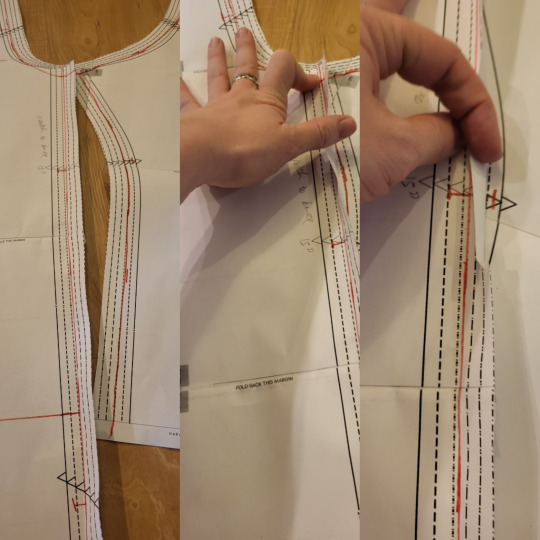
The next step, walking the pattern, is a little tricky to explain. Here's a post that goes into it in great detail.
Basically, you're going to overlap the seam lines, to make sure they line up. The only problem with doing this is that both seam lines are curved. So, instead of lining it all up at once, you're going to go about an inch at a time, letting the pattern rotate so that it stays flat on the table. At any given point, you're only going to have an inch or so of the line overlapping, but that's all you need. If you run into notches that don't line up, cross one out and re-draw it so that it matches the other notch.
If this seems really complicated, you don't really need to do that on this project. It just is a good practice to have.
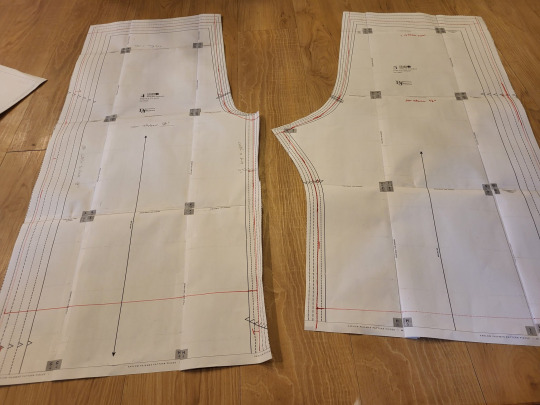
So you now should have a pattern with all the commercial markings, but where you've drawn the stitching line.

So now, you're going to put your two pieces together along the outseam. Since this is a pretty straight part of a pajama pant, it shouldn't be too difficult to get them to line up. Remember to overlap them on your stitching line, and not on the edge of the pattern.
We're putting them together so that you can measure them both at the same time. it saves us some math.

In bloomers, there are three major measurements to take into consideration. You need to know how big you want the leg to be, how big you want the booty to be, and how long you want the leg of the bloomer to be. In addition, you need to make sure that the waist of your pants will be big enough to fit your waist. In most pajama pants patterns, this isn't a problem, but checking it is good practice.
So, in this picture, you can see that I've measured the cuff of the pants. These two pieces together make up one pant leg, so I just need to measure the two pieces to know how big the pant leg will be.

I then take my tape measure and hold it around my leg at the same size that the pattern is at that point. I just use my eyes and judge if I think that'll be enough room to make my bloomers nice and poofy.

If your pattern doesn't tell you your hip line (mine didn't), it's usually at the point where the two notches on the crotch curve are. One of the reasons why we're doing this on a commercial pattern is that someone did the work for us and put those notches where they should be.
Now, remember, these two pieces are only half of the pant pattern. When we measure the hips of the pattern, we have to multiply this measurement by 2. Half the hip measurement x 2 is the full hip measurement.

Once again, hold this out next to your body and make sure that you like how much fullness you need. Remember that, in addition to having extra fullness because bloomers are poofy, you need room to be able to move and sit down. This measure between the size of my body and the size of the pattern looked pretty good to me. I could definitely have gone a little bit bigger.
The pant leg measurement is okay to be a little bit too long. You can always make it shorter. However, feel free to chop about 18" off the bottom of a full length pant leg. This just makes things a little easier.

Now, we're going to move the two pattern pieces until they're the size we like. If both the hip measurement and the leg measurement are too small, we're going to move both pattern pieces apart. To turn pajama pants into bloomers, this is likely to be the most common adjustment.
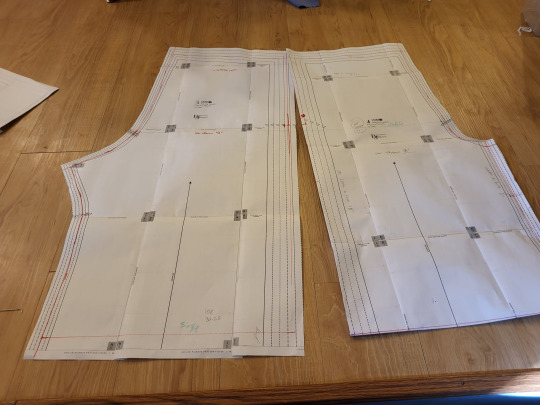
If the hip measurement is pretty okay, but the cuff measurement is too small, you're just going to move the bottom part of the pattern apart.
You'll notice that this is still enlarging the hip measurement a little bit. This is fine for bloomers since the style is for a lot of fullness in that area.

And if your cuff is the correct size, but your hip measure is too big, you can keep the cuff size the same and move the hip line apart until it's the size you want.
This technique of lining up the pattern pieces, and then moving them until they're the size you want, is the basics of flat patterning. As long as you follow the philosophy of keeping the measurements you like roughly the same, and moving the areas that you don't like until they measure what you need, you can easily resize a pattern without having to re-draw everything.
If you had to spread your pieces apart, tape some paper underneath the gap. This piece of paper should bridge the gap between the two pieces, turning them into one piece. Really quickly double-check that these pieces measure how you want. Then, mark a line in the middle of the paper bridge. Draw your notches onto the cut line. Cut the two pieces apart on that line. You've now made both pieces bigger. Tape another little piece of paper onto the cut edge of each piece, mark out your seam allowance, and cut that off.
Bonus points: swap the position of the pattern pieces, so that the crotch curve is one continuous line. Measure the length of that. Then, hold your tape measure along where the crotch curve of your pants will fit, and make sure that you have clearance there. I'm not going to photograph that, andi t's not super necessary with most pajama patterns.
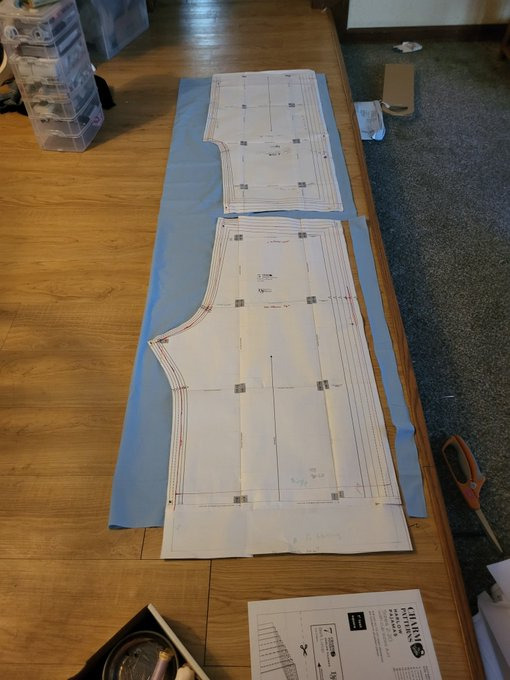
Go ahead and cut your pieces out.Even though I'd shortened the pattern, mine were still too long to fit on a 2-yard cut of fabric. Since I knew that my pants were a little long, I just let the end hang off the edge of the fabric.
Here's the really magical part about this. Even though you've resized your pattern, you still have all your seam allowance, notches, grainlines, and your pattern instructions. Since you kept all your pattern markings consistent, you can now follow the instructions that came with your pattern. Go up until it tells you to hem the pants, and then try them on.
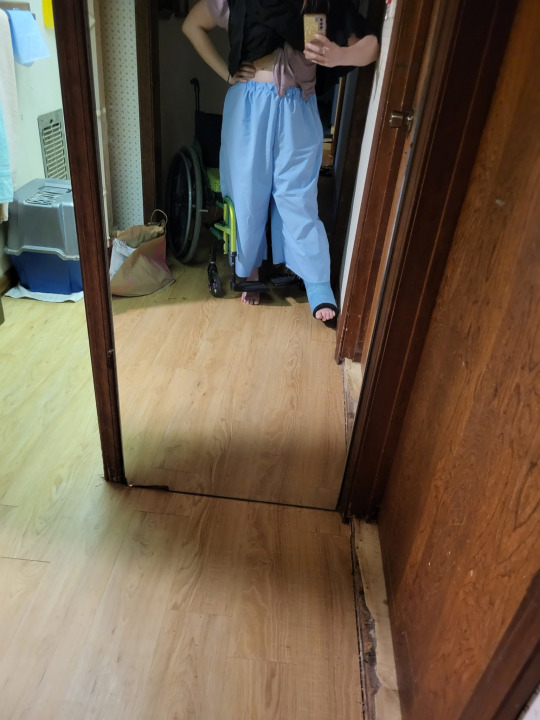
In my case, my pants were way too long to be bloomers. I knew that I wanted to do a casing with a heading, which does use s pretty big hem allowance, but even so, I'd need to shorten them.
Check out your bloomer research board to see how long you want them to be. I wanted some long ones that did the old-school bloomer peek, so I made them on the longer side. I also didn't want them to ride up into my butt when sitting in a wheelchair.
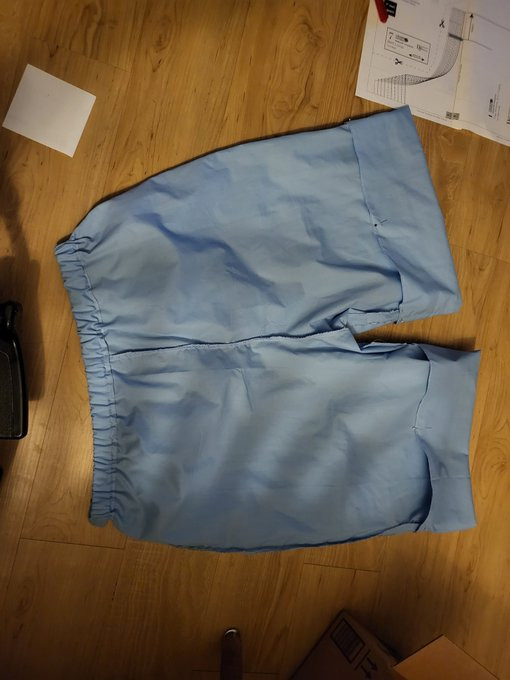
So, time to fold up the bottoms, add my elastic, and call the basic construction finished.
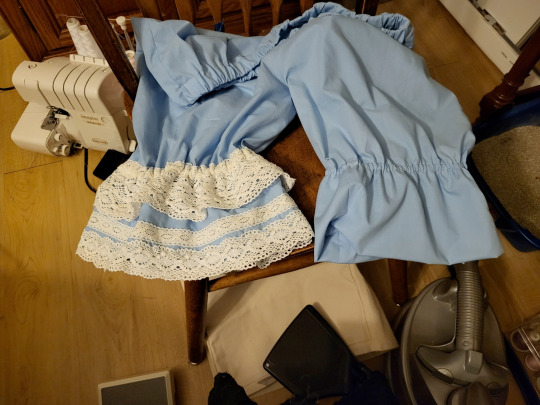
I looked up on my research board to try to find a good way to decorate these. One of the nice things about bloomers is that you can wear them with a wide variety of coords. This makes them one of those items where you can add some extra lace, and then use that lace in multiple coords. I feel like, since these bloomers are a good way of adding detail in multiple coords, it's a good excuse to add a little bit extra lace. You can see how much of a difference it makes in this picture. It really turns them from baggy shorts into real bloomers. I really recommend sometimes investing in a couple of big purchases of lace. If you have lots of lace on hand, you're more likely to include it in your projects, which can really help push a meh project into proper lolita fashion territory. I have a rule that I don't spend more than $1.50 a yard on lace unless it's really fantastic, and I manage to find things at that point on Aliexpress and sites like Cheeptrims.

Now go on and let them peek out of your favorite skirt. And remember, definitely don't press that skirt before putting this picture in your tutorial.
#20dollarlolita#dollar chan's pattern school#step 2#lolita fashion#patternmaking#handmade lolita#lolita bloomers#sewing tutorial#hey guys look i actually made somethign#long post
92 notes
·
View notes
Text
Those nuclear bomb Bing transcripts are insanely impressive to me, I can't believe this kind of thing is actually possible now.
Like, in 1968 when Kubrick asked Marvin Minsky what the state of AI would be like in 2001 they came up with HAL9000, and then in the actual year 2001 we had realized a natural language interface like that is completely unrealistic and nobody knew even where to start, and now suddenly they arrived.
Of course, in 1968 the expectation was that it would be achieved by understanding how natural intelligence works via cognitive science etc, and now we have a hundred trillion floating point numbers and still don't understand anything at all. The bitter lesson indeed.
127 notes
·
View notes
Note
what's the library of babel?
The Library of Babel is an archive of all arrangements of information, recorded in all encoding schema that can be used to represent that information. Examples of resources catalogued within the Library include:
the source code for the Apollo 11 guidance computer
the objectively best chocolate chip cookie recipe
a beam of photons whose frequencies recreate the audio of two humans having a conversation in a Minoan language
a complete history of this universe, presented as a fully accurate H0 scale replica
a list of all lists which do not list themselves as entries
Pounded In The Butt By My Handsome Sentient Library Card Who Seems Otherworldly But In Reality Is Just A Natural Part Of The Priceless Resources Our Library System Provides, by Chuck Tingle
The Library of Babel.
In common usage, "the Library of Babel" refers not to the entire library but to the particular Public Access Catalogue of the Library that has been assigned to this locale; this Public Access Catalogue is an archive of all possible arrangements of information that can be encoded as a book consisting of 410 pages of each consisting of 3200 characters selected from the 26 lowercase characters of the Latin alphabet, the space, the comma, and the period.
"The Library of Babel" may also refer to the short story written by Jorge Luis Borges which has this phrase as its English title. Borges' story portrays the previously mentioned Public Access Catalogue as a physical library consisting of tangible rooms, shelves, and texts. It is remarkably factual in its depiction of the Catalogue's contents, though it does contain a number of key inaccuracies. (Namely, the librarians do not engage in the destruction of library resources or other such superstitions and, due to local standards limiting the compression of information, all indices of the Public Access Catalogue's contents are not considered to be part of the Catalogue itself, and are instead classified as Semi-Limited Special Resources.)
Alternatively, "the Library of Babel" may denote the front-end user interface for the Library's Public Access Catalogue, which was created independently by Jonathan Basile and draws inspiration from the short story written by Borges.
147 notes
·
View notes
Text

The Power of Voice User Interfaces (VUIs) in Web Apps
Discover the power of Voice User Interfaces in web apps! Enhance accessibility, efficiency, and multitasking. Have a look and explore our infographic for more insights.
#Voice User Interfaces#Natural Language Processing#Conversational Interfaces#web application#User Experience#user experience design#web application development
1 note
·
View note
Note
Hey! At first, I want to say that really adore your essays. I found your blog shortly after I joined tumblr and it was a great beginning.
My question is not only about Loki. Few times you mentioned that queer subtext always existed in cinema. So I wanted to know more about it. Are there any common tricks which artists use? How can we know that it isn't just our imagination?
And if you could give some literature recommendations on this topic I'd be thrilled :)
Hi Anon!
This is a really important question. I’m so glad you asked it, so I’ve bumped you to the front of my inbox queue.
Superhell (Destiel). Superheaven (Aziracrow). Supertime (Lokius). It’s not an accident these types of tragic queer endings are a pattern in our TV media. Though of the three, Good Omens is the most likely to deliver a happy ending eventually, the resources I provide below contextualize why queer subtext and queer tragedy persists. I believe the paper on Cat on a Hot Tin Roof is a particularly important read as it sheds light on tragic queer tropes and utilization of queer subtext from the 1950s that persist to this day.
I do need to clarify a few things:
1.) I’m not a formal scholar. I don’t have a Master’s, let alone a PhD. I would love to continue my education, but I only just finished paying off my student loans. This is to say, most of what I’ve learned is from self-guided reading, watching documentaries, and talking to literary and cinematic professionals and members of the LGBTQAI+ community.
2.) Subtext exists in all forms of art: literature, music, painting, sculptures, film, and so on. There is no 1-to-1 definition of what subtext could be because subtext, by its very definition, is the communicating of information and/or a feeling without communicating it directly. It’s also important to remember that we use subtext in everyday life without realizing it.
3.) It’s necessary to share foundational resources in order to provide a greater contextual understanding in response to your question. The resources I'll be sharing, which will go from broad foundational to specifically queer subtext in cinema, are as follows: A.) Using JSTOR, B.) Linguistics & Subtext, C.) Film History, D.) Queer Subtext in Literature, Theater, and Film.
USING JSTOR
JSTOR is an incredible academic journal article resource. You can sign-up as a user and have access to up to 100 articles per month online for free! If you don’t feel comfortable creating an account, you can also visit your local library, who more likely than not have a JSTOR membership.
When searching for articles, I recommend using these keywords: queer, homosexuality, subtext, literature, film, history.
LINGUISTICS & SUBTEXT
Pragmatics
-- Jerome Bruner’s “Pragmatics of Language and Language of Pragmatics” (Available on JSTOR; Published by The Johns Hopkins University Press)
-- Kristin Borjesson’s “The Semantics-Pragmatics Interface: The Role of Speak Intentions and Nature of Implicit Meaning Aspects” (Available on JSTOR; Published by Armand Colin)
Iceberg Theory and Theory of Omission
-- Silvia Ammary’s “Poe’s ‘Theory of Omission” and Hemingway’s ‘Unity Effect’” (Available on JSTOR; Published in the Edgar Allan Poe Review)
-- Charles J. Nolan, Jr’s “‘Out of Season’: The Importance of Close Reading’” (Available on JSTOR; Published in the Rocky Mountain Review of Language and Literature)
-- Paul Smith’s “Hemingway’s Early Manuscripts: The Theory and Practice of Omission” (Available on JSTOR; Published by Journal of Modern Literature)
Implicature
-- Catherine Abell’s “Pictorial Implicature” (An important read as it provides academic context on interpretation of the visual medium, which is connected to interpretation of film; Available on JSTOR; Published by The American Society for Aesthetics)
-- Eric Swanson’s “Omissive Implicature” (Linguistic study on implied communication through omission) Available on JSTOR; Published by University of Arkansas Press)
-- Jacques Moeshcler’s “On the Pragmatics of Logical Connectives” (Published in the book: “Aspects of Linguistic Variation)
Exformation
-- David Foster Wallace’s “Laughing with Kafka” (Yes, the same writer of the book, Infinite Jest! A quick 4-page read that explains exformation in literature using Kafka as an example; Available on JSTOR; Published in Log by Anyone Corporation)
-- Stephen J. Burn’s “Reading the Multiple Drafts Novel” (23 pages; can be a slog to read, but it addresses the issues of “canon”; Available on JSTOR; Published by The Johns Hopkins University Press)
FILM HISTORY
Generally, I recommend looking up Hollywood History pre-code (Hays Code aka the Motion Picture Production Code from 1930-1967). Notice that the code’s abandonment was gradual in the 60s, which was when the U.S.’s sexual revolution occured. The MPAA Film Rating System went into effect in 1968.
Sin if Soft Focus: Pre-Code Hollywood by Mark A. Vieira
Available in hard cover on Amazon (looks like there’s only 1 copy left); no digital version that I can find. You may be able to find this at your library.
Forbidden Hollywood: The Pre-Code Era (1930-1934): When Sin Rules the Movies by Mark A. Vieira
Available on Kindle. Similar to Vieira’s first book but considered inferior.
The Celluloid Closet: Homosexuality in the Movies by Vito Russo
Published in the 1980s, a groundbreaking work and the first of its kind. It’s dated but still considered critical reading.
Screening the Sexes: Homosexuality in the Movies by Parker Tyler
Available in hardcover and paperback. This is also considered critical reading to be paired with Celluloid Closet.
Images in the Dark: An Encyclopedia of Gay and Lesbian Film and Video by Raymond Murray
Available in paperback on Amazon (1 copy left); likely to be in the library as well.
QUEER SUBTEXT IN LITERATURE, THEATER, AND FILM
Queerbaiting and Fandom: Teasing Fans through Homoerotic Possibilities
The first book of its kind, published in 2019. A must-read as contributing articles include analysis on Supernatural, Sherlock, and Merlin, among many others. I highly recommend reading the entire book, but it is expensive. You may be able to find this at your library.
My recommended articles from this book:
-- Joseph Brenann’s “Introduction: A History of Queerbaiting” is critical to understanding the Loki series specific place in queer fandom and media history.
-- Monique Franklin’s “Queerbaiting, Queer Readings, and Heteronormative Viewing Practices”
-- Guillaume Sirois’s “Hollywood Queerbaiting and the (In)Visibility of Same-Sex Desire
-- Christoferr Bagger’s “Multiversal Queerbaiting: Alan Scott, Alternate Universes, and Gay Characters in Superhero Comics”
Fandom: Identities and Communities in a Mediated World
About half the price of Queerbaiting and Fandom but significantly more broad in scope.
My recommended articles from this book:
-- Cornel Sandvoss’s The Death of the Reader? Literary Theory and the Study of Texts in Popular Culture
-- Derek Johnson’s “Fantagonism: Factions, Institutions, Constitutive Hegemonies of Fandom”
Sir Gawain and the Green Knight (Reading of epic poem recommended)
-- David L. Boyd’s “Sodomy, Misogyny, and Displacement: Occluding Queer Desire in Sir Gawain and the Green Knight" (available on JSTOR; from Arthuriana published by Scriptorium Press)
Oscar Wilde’s The Picture of Dorian Gray (Reading the novel recommended)
-- Jeff Nunokawa’s “Homosexual Desire and the Effacement of the Self in ‘The Picture of Dorian Gray’” (available on JSTOR; Published by The Johns Hopkins University)
-- Ed Cohen’s “Writing Gone Wilde: Homoerotic Desire in the Closet of Representation” (available on JSTOR; Published by Cambridge University Press)
-- Sandra Mayer’s “‘A Complex Multiform Creature’: Ambiguity and Limitation Foreshadowed in the Early Critical Reception of Oscar Wilde” (available on JSTOR; Published in AAA: Arbeiten aus Anglistik und Amerikanistik)
Tennessee Williams’s Cat on a Hot Tin Roof (Reading the short story [“Three Players of a Summer Game” and stage play and watching the film adaptation highly recommended)
-- Dean Shackelford’s “The Truth That Must Be Told: Gay Subjectivity, Homophobia, and Social History in “‘Cat on a Hot Tin Roof’”. (A must-read, in my opinion. You see a lot of patterns that continue in our subtextual queer stories to this day, concerning since Williams’s play was written in the early 1950s. Available on JSTOR; published in The Tennessee Williams Annual Review)
I hope these resources are helpful and interesting to you! Happy reading!
#loki#mobius#lokius#loki series#queer literature#queer media#queer representation#linguistics#subtext#queer film#lgbt representation#lgbtqia representation#lgtbqia+#lgbtq community#asks#literary resources#film resources#Good Omens#Supernatural#aziracrow#Destiel#my meta#meta tools#meta resources#bisexuality
31 notes
·
View notes